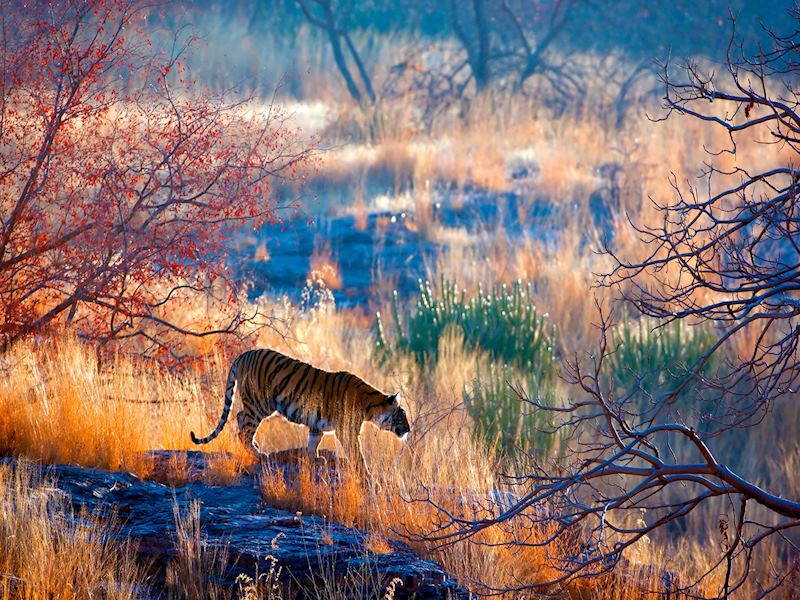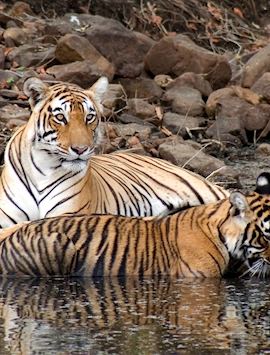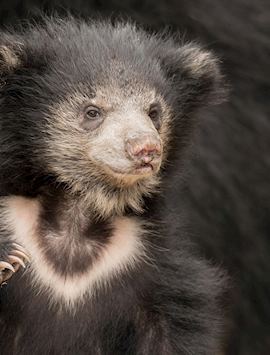By India specialist Sophie
Hundreds of national parks and sanctuaries are scattered across India, many with the raison d'être to protect the country’s most remarkable beast: the Bengal tiger. India’s national animal is the star, but the wildlife opportunities in Indian national parks are many layered. Sloth bears and leopards lurk in the shadows while herds of deer and elephant roam freely. The air flutters with electric-blue butterflies and brightly feathered birds.
It can be hard to decide which area to focus on but, for me, the parks of central India offer particularly biodiverse landscapes, as well as the most successful tiger safaris.
India’s central parks

The network of national parks spread across India’s three central states, Madhya Pradesh, Maharashtra and Chhattisgarh, are well set up for wildlife spotting. The lodges and hotels have honed their skills, employing enthusiastic staff and knowledgeable naturalists.
For the best experience, I suggest dedicating your time to just a couple of the parks — otherwise you can bet a tiger is sighted the day you’re driving in-between two of them. I’ve chosen the four parks that have impressed the most, each offering its own distinct wildlife experience, to choose from.
Safaris in Kanha National Park

Visit Kanha in February or March and you’ll find the plains ablaze with shocks of red flowers. The flame of the forest, a type of deciduous butea tree, is in full bloom. Outside this period, the landscape of yellow-green meadows and lakes with petrified trees jutting up from them still holds its interest.
Kanha is well-known for its flourishing tiger population and, while not guaranteed, you stand a good chance of sightings. On one afternoon jeep safari, we’d almost given up hope of spotting one. Suddenly, an awful smell hit us and a tiger emerged from the undergrowth dragging a huge wild boar carcass. I hadn’t appreciated how large tigers were until I’d seen one pulling a 90 kg (14 stone) boar with ease.
Aside from tigers, large numbers of deer and blue bulls graze the meadows, and Indian marsh crocodiles lurk near the lakes. You might also spot Indian jackals in small packs and, if you’re very lucky, a leopard.
All safaris in Kanha are by jeep, but many lodges offer walks through the park’s buffer zone that concentrate on birdlife and flora. Lodges also supply bicycles for you to visit some of the local traditional villages populated by the forest-dwelling Gond and Baiga tribes.
How to get to Kanha
The park is best reached by a domestic flight from Delhi to Jabalpur, the closest airport city. From Jabalpur, it’s a three-hour drive to the park.
Where to stay in Kanha


There are plenty of places to stay around Kanha but, for me, the six canvas tents at Shergarh are hard to beat. Run by a local naturalist and his English wife, the camp is set in a forested area overlooking a freshwater lake. Guests eat together in the main house, and the menu of home-cooked dishes often has an Anglo-Indian twist.
The camp’s naturalists are on hand to take you on walks into the surrounding deciduous forest, along trails well-worn by local villagers. On foot, my naturalist, Rajan, could point out details we’d missed by jeep, including some fresh leopard scat and claw marks in the dust. Turquoise mormon and blue oakleaf butterflies danced around us as we walked, one briefly landing on my shoulder.
Satpura National Park

There’s less focus on tigers at Satpura, although they do live in the vicinity. Sloth bears and leopards take the stage instead, as well as packs of wild dog, the bison-like Indian gaur and sambar deer.
Walking deep into the forest with my naturalist, I could appreciate the smaller animals, including Malabar giant squirrels and clouds of endemic butterflies.
The Denwa River and its tributaries run through Satpura’s gorges and ravines, enabling you to explore by canoe as well as jeep. It’s also the only national park where you can walk on foot inside its boundaries.
I rose early one morning for a canoe safari. The only boat on the river, our canoe’s quiet motion did nothing to interrupt the still of the morning. We pulled onto a riverbank for breakfast as the sun began to rise. As we sat, a family of more than 20 wild boars swam across the river, completely oblivious to our presence. The group swam in a diamond shape, the babies in the middle to protect them from gharials.
The birdwatching at Satpura is among the best I’ve experienced in India, as the waterholes, rivers and lakes provide a variety of environments for endemic and migratory birds. As well as a small colony of the rare Indian skimmer, more than ten types of eagles live here.
How to get to Satpura
Satpura connects well with Kanha, and visiting both parks gives you a good chance of seeing a mix of wildlife. From Kanha, you take a two-hour train journey to Satpura, passing through the Madhya Pradesh countryside.
Where to stay in Satpura


While Reni Pani isn’t in the national park proper, its secluded location surrounded by the thick forest has a middle-of-the-jungle feel. Each of the 12 cottages has a veranda where you can sit and listen for wildlife.
The lights go out around the lodge at evening time so as to not disrupt the wildlife (sloth bears have been sighted in the grounds), which means on a clear night you can see the smallest of stars. Dinner is served under the boughs of a fig tree before guests gather for a nightcap around the bonfire.
Pench National Park

Sat between Kanha and Satpura, Pench is a good addition for a safari if you have the time. It’s a well-populated tiger park, although its huge size and dense forest can make the animals tricky to spot. Fewer visitors lend the park a particularly tranquil feel.
A healthy colony of wild dogs and large herds of gaur roam here, and the teak forests hide the rare flying squirrel. With extreme luck or patience you might see a civet, jungle cat or porcupine.
Due to the small visitor numbers, Pench is a park where you can take a jeep safari to a quiet corner and wait to see what emerges from the jungle. As I watched, a blue-black Asian forest scorpion scuttled across the ground and proceeded to attack the wheel of the jeep with vigor.
Where to stay in Pench


Visiting Pench gives you the opportunity to stay at Jamtara Wilderness Camp, ten luxurious safari tents set in an arjuna tree forest.
You can spend a night of your stay sleeping under the stars on a local farmer’s machaan, a stilted platform positioned above a paddy field (traditionally used to guard crops from elephants). A guard is nearby if you need assistance.
A private entrance into the park is only a five-minute drive away, giving you more time in bed than the other camps allow. After a day’s safari, guests congregate under the trailing arms of a banyan tree for drinks around a fire pit.
Tadoba National Park

It may be one of India’s oldest national parks, but Tadoba has remained off most itineraries — the limited number of places to stay keeps visitor numbers low. The park boasts the highest density of tigers in India, although the dense forest setting means sightings aren’t guaranteed.
In the hotter months, from March to May, the vegetation dies back and the smaller pockets of water dry out, bringing the tigers to the larger waterholes. Sightings are frequent, and I saw a leopard skulking across to the waterside to drink, as well as a pair of civets.
All safaris in the park are conducted by jeep, accompanied by a trained naturalist. When I visited in October, the forest was lush with post-monsoon growth. As the tigers were particularly difficult to spot, my naturalist used track marks and jungle noises to predict where a tiger might emerge, leading us to the spot where a female emerged from the undergrowth into the sunlight.
I’ve long been fascinated with sloth bears. Rudyard Kipling celebrated the species through his character Baloo in The Jungle Book, and modern adaptations of the story have helped conservation efforts to protect the bear, which is native to India’s central parks.
On one afternoon safari in Tadoba, as the light dimmed, we happened upon a pair of sloth bears sloping across the path in front of us, with their distinctive shaggy fur and loping gait. The driver slowed and we trailed them — the pair remained completely unfazed by our presence — until dark.
As you track the larger animals, you’re likely to encounter a variety of birdlife as well as gaurs, langurs, four-horned antelopes (chausinghas in Hindi) and mugger crocodiles. I also spotted a wolf spider the size of my hand.
How to get to Tadoba
Tadoba is a domestic flight from Nagpur, which connects with Delhi and Mumbai, then a three-hour drive. You can combine a safari in Tadoba with Pench National Park (a five- to six-hour drive), carrying onto Satpura or Kanha from there.
Where to stay in Tadoba
Family-run Svasara Jungle Lodge has 12 well-kept cottages in a relaxed environment and the appeal of a swimming pool for the hotter months.
Audley and TOFT

Audley is a member of Travel Operators for Tigers (TOFT), which together with Global Tiger Patrol supports a sustainable approach to tourism in the Indian Subcontinent’s wildlife reserves.
Key to TOFT’s work is showing the local community that tigers are more valuable alive than dead. A current focus involves encouraging local people to become watchmen or guides so they can make a living while protecting the tiger population.
We make a donation for everyone who ĚÇĐÄvlog´«Ă˝ with us to one of India's national parks where tigers are present.
TOFT also visits a number of lodges in India, helping to promote sustainable practices. All the properties we work with have an eco-rating (known as a pug mark), which you can see on TOFT’s website. You can also download one of to take with you.
Best time to spot wildlife in India
In February and March, the temperatures average a comfortable 27°C (80°F), rain is rare and the foliage starts to thin out, making wildlife easier to spot. If you can handle warmer temperatures, in April and May the water sources dry out, drawing animals from the jungle to larger lakes, which can lead to some very successful sightings.
The parks close to visitors roughly from June to mid-October, when the monsoon rains fall. India then descends into wintertime. December and January are the coldest months, and I suggest packing thermals, hats and gloves if you visit during this time. Due to the cold weather, mammal sightings are rare but the great migration of sub-Himalayan birds brings eagles, herons and storks down to the plains.
How to make the most of a wildlife trip to India
- Safari permits go on sale well in advance, and there are more hotel rooms than permits for most parks: I advise planning your trip 9 to 12 months ahead.
- Consider adding in some cultural exploration. If it’s your first time in India, the Taj Mahal is a simple addition before flying home from Delhi. If you’re a more seasoned visitor, you could fly home via Mumbai.
- Regardless of when you visit, it can be surprisingly chilly on early morning game drives so I suggest taking a jacket or fleece. In dry weather it can also get very dusty, so a scarf can be helpful.
- To reduce the impact on the environment, safaris are conducted in shared jeeps of usually no more than eight people (including the driver and naturalist), with space to stretch out and take photographs. Some parks occasionally offer private jeeps, but these are hard to guarantee.
- The parks of central India never teem with international visitors, but the country has a budding wildlife culture and many Indians visit. During festival time, when many Indians take time off, the parks can get very busy.
Start planning your India wildlife trip
Start thinking about your experience. These itineraries are simply suggestions for how you could enjoy some of the same experiences as our specialists. They're just for inspiration, because your trip will be created around your particular tastes.
View All Tours in India



